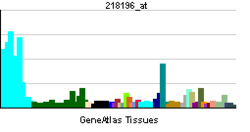- OSTM1
-
Osteopetrosis associated transmembrane protein 1 Identifiers Symbols OSTM1; GIPN; GL; OPTB5 External IDs OMIM: 607649 MGI: 2655574 HomoloGene: 32203 GeneCards: OSTM1 Gene Gene Ontology Cellular component • cytosol
• membrane
• integral to membraneBiological process • osteoclast differentiation Sources: Amigo / QuickGO RNA expression pattern 
More reference expression data Orthologs Species Human Mouse Entrez 28962 14628 Ensembl ENSG00000081087 ENSMUSG00000038280 UniProt Q86WC4 Q8BGT0 RefSeq (mRNA) NM_014028 NM_172416.3 RefSeq (protein) NP_054747 NP_766004.1 Location (UCSC) Chr 6:
108.36 – 108.49 MbChr 10:
42.3 – 42.42 MbPubMed search [1] [2] Osteopetrosis-associated transmembrane protein 1 is a protein that in humans is encoded by the OSTM1 gene.[1][2][3]
This gene encodes a protein that may be involved in the degradation of G proteins via the ubiquitin-dependent proteasome pathway. The encoded protein binds to members of subfamily A of the regulator of the G-protein signaling (RGS) family through an N-terminal leucine-rich region. This protein also has a central RING finger-like domain and E3 ubiquitin ligase activity. This protein is highly conserved from flies to humans. Defects in this gene may cause the autosomal recessive, infantile malignant form of osteopetrosis.[3]
The OSTM1 gene is regulated by the Microphthalmia-associated transcription factor.[4][5]
Interactions
OSTM1 has been shown to interact with RGS19.[6]
References
- ^ Chalhoub N, Benachenhou N, Rajapurohitam V, Pata M, Ferron M, Frattini A, Villa A, Vacher J (Apr 2003). "Grey-lethal mutation induces severe malignant autosomal recessive osteopetrosis in mouse and human". Nat Med 9 (4): 399–406. doi:10.1038/nm842. PMID 12627228.
- ^ Abrahams BS, Mak GM, Berry ML, Palmquist DL, Saionz JR, Tay A, Tan YH, Brenner S, Simpson EM, Venkatesh B (Jun 2002). "Novel vertebrate genes and putative regulatory elements identified at kidney disease and NR2E1/fierce loci". Genomics 80 (1): 45–53. doi:10.1006/geno.2002.6795. PMID 12079282.
- ^ a b "Entrez Gene: OSTM1 osteopetrosis associated transmembrane protein 1". http://www.ncbi.nlm.nih.gov/sites/entrez?Db=gene&Cmd=ShowDetailView&TermToSearch=28962.
- ^ Meadows NA, Sharma SM, Faulkner GJ, Ostrowski MC, Hume DA, Cassady AI (2007). "The expression of Clcn7 and Ostm1 in osteoclasts is coregulated by microphthalmia transcription factor". J. Biol. Chem. 282 (3): 1891–904. doi:10.1074/jbc.M608572200. PMID 17105730.
- ^ Hoek KS, Schlegel NC, Eichhoff OM, Widmer DS, Praetorius C, Einarsson SO, Valgeirsdottir S, Bergsteinsdottir K, Schepsky A, Dummer R, Steingrimsson E (2008). "Novel MITF targets identified using a two-step DNA microarray strategy". Pigment Cell Melanoma Res. 21 (6): 665–76. doi:10.1111/j.1755-148X.2008.00505.x. PMID 19067971.
- ^ Fischer, Thierry; De Vries Luc, Meerloo Timo, Farquhar Marilyn Gist (Jul. 2003). "Promotion of Gαi3 subunit down-regulation by GIPN, a putative E3 ubiquitin ligase that interacts with RGS-GAIP". Proc. Natl. Acad. Sci. U.S.A. (United States) 100 (14): 8270–5. doi:10.1073/pnas.1432965100. ISSN 0027-8424. PMC 166218. PMID 12826607. http://www.pubmedcentral.nih.gov/articlerender.fcgi?tool=pmcentrez&artid=166218.
Further reading
- Zhang QH, Ye M, Wu XY et al. (2001). "Cloning and Functional Analysis of cDNAs with Open Reading Frames for 300 Previously Undefined Genes Expressed in CD34+ Hematopoietic Stem/Progenitor Cells". Genome Res. 10 (10): 1546–60. doi:10.1101/gr.140200. PMC 310934. PMID 11042152. http://www.pubmedcentral.nih.gov/articlerender.fcgi?tool=pmcentrez&artid=310934.
- Strausberg RL, Feingold EA, Grouse LH et al. (2003). "Generation and initial analysis of more than 15,000 full-length human and mouse cDNA sequences". Proc. Natl. Acad. Sci. U.S.A. 99 (26): 16899–903. doi:10.1073/pnas.242603899. PMC 139241. PMID 12477932. http://www.pubmedcentral.nih.gov/articlerender.fcgi?tool=pmcentrez&artid=139241.
- Fischer T, De Vries L, Meerloo T, Farquhar MG (2003). "Promotion of Gαi3 subunit down-regulation by GIPN, a putative E3 ubiquitin ligase that interacts with RGS-GAIP". Proc. Natl. Acad. Sci. U.S.A. 100 (14): 8270–5. doi:10.1073/pnas.1432965100. PMC 166218. PMID 12826607. http://www.pubmedcentral.nih.gov/articlerender.fcgi?tool=pmcentrez&artid=166218.
- Clark HF, Gurney AL, Abaya E et al. (2003). "The Secreted Protein Discovery Initiative (SPDI), a Large-Scale Effort to Identify Novel Human Secreted and Transmembrane Proteins: A Bioinformatics Assessment". Genome Res. 13 (10): 2265–70. doi:10.1101/gr.1293003. PMC 403697. PMID 12975309. http://www.pubmedcentral.nih.gov/articlerender.fcgi?tool=pmcentrez&artid=403697.
- Ota T, Suzuki Y, Nishikawa T et al. (2004). "Complete sequencing and characterization of 21,243 full-length human cDNAs". Nat. Genet. 36 (1): 40–5. doi:10.1038/ng1285. PMID 14702039.
- Ramírez A, Faupel J, Goebel I et al. (2004). "Identification of a novel mutation in the coding region of the grey-lethal gene OSTM1 in human malignant infantile osteopetrosis". Hum. Mutat. 23 (5): 471–6. doi:10.1002/humu.20028. PMID 15108279.
- Quarello P, Forni M, Barberis L et al. (2004). "Severe malignant osteopetrosis caused by a GL gene mutation". J. Bone Miner. Res. 19 (7): 1194–9. doi:10.1359/JBMR.040407. PMID 15177004.
- Gerhard DS, Wagner L, Feingold EA et al. (2004). "The Status, Quality, and Expansion of the NIH Full-Length cDNA Project: The Mammalian Gene Collection (MGC)". Genome Res. 14 (10B): 2121–7. doi:10.1101/gr.2596504. PMC 528928. PMID 15489334. http://www.pubmedcentral.nih.gov/articlerender.fcgi?tool=pmcentrez&artid=528928.
- Otsuki T, Ota T, Nishikawa T et al. (2007). "Signal sequence and keyword trap in silico for selection of full-length human cDNAs encoding secretion or membrane proteins from oligo-capped cDNA libraries". DNA Res. 12 (2): 117–26. doi:10.1093/dnares/12.2.117. PMID 16303743.
Categories:- Human proteins
- Chromosome 6 gene stubs
Wikimedia Foundation. 2010.
